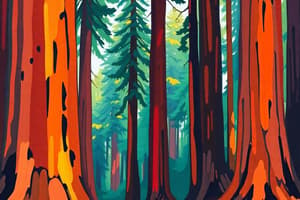Podcast
Questions and Answers
What is the main objective of Archangel Ancient Tree Archive, as mentioned in the text?
What is the main objective of Archangel Ancient Tree Archive, as mentioned in the text?
Why are old-growth forests important in the context of global warming?
Why are old-growth forests important in the context of global warming?
What makes David Milarch's tree cloning project unique?
What makes David Milarch's tree cloning project unique?
What is one of the potential benefits mentioned in the text associated with planting cloned trees?
What is one of the potential benefits mentioned in the text associated with planting cloned trees?
How does David Milarch describe his work ethic in the text?
How does David Milarch describe his work ethic in the text?
What was the main factor contributing to the decline in the elephant population in Cambodia?
What was the main factor contributing to the decline in the elephant population in Cambodia?
How did Vathana help Cambodian farmers protect their crops from elephants?
How did Vathana help Cambodian farmers protect their crops from elephants?
What was one of the methods used by farmers to protect their farms at night from elephants?
What was one of the methods used by farmers to protect their farms at night from elephants?
In addition to wildlife conservation education, what did Vathana help establish for Cambodian farmers?
In addition to wildlife conservation education, what did Vathana help establish for Cambodian farmers?
What role did Vathana play in changing the cultural perception of Cambodians towards elephants?
What role did Vathana play in changing the cultural perception of Cambodians towards elephants?
Flashcards are hidden until you start studying
Study Notes
Reversing Global Warming through Ancient Trees
- Old-growth forests play a crucial role in maintaining a clean atmosphere, but 98% of these forests have been destroyed due to logging, development, pollution, and disease, contributing to global warming.
- David Milarch and Leslie Lee, co-founders of Archangel Ancient Tree Archive, are cloning trees from over 60 of the world's oldest and largest species to combat global warming.
- These cloned trees include California's redwoods and sequoias, Ireland's ancient oaks, and Lebanon's historic cedars, some of which are over 2,000 to 3,000 years old.
- The goal is to have people buy and plant these cloned trees, which can produce oxygen, absorb carbon, and even be used in the manufacture of medications.
- Milarch aims to clone over 200 different species and restore some of the old-growth forests lost to human activity.
Protecting Wildlife in Cambodia
- Cambodia's population growth and unregulated development have led to environmental destruction, causing a conflict between humans and wild Asian elephants.
- Elephants searching for food have destroyed farms, leading poor and uneducated farmers to kill them to protect their livelihoods.
- By the early 2000s, the elephant population had fallen dramatically from 2,000 to 500.
- Tuy Sereivathana (Vathana) worked to conserve Cambodia's natural resources, focusing on understanding the problems faced by farmers and helping them develop practical solutions to protect their farms.
- Vathana's methods included building electric fences, using hot chili peppers and native plants to deter elephants, and organizing farmers to guard their farms at night.
- He also established community schools to increase literacy and provide wildlife conservation education, redeveloping cultural pride in Cambodia's elephants.
- As a result, there has not been a single killing of a wild Asian elephant since 2005, and the farmers have become the elephants' greatest protectors.
Studying That Suits You
Use AI to generate personalized quizzes and flashcards to suit your learning preferences.





